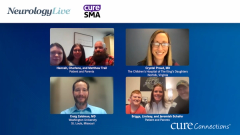
Screening Newborns for SMA
Craig Zaidman, MD, discusses how critically important newborn SMA screening is and early diagnosis and treatment of SMA.
Episodes in this series

Crystal Proud, MD: I’d like to shift gears a little and talk about screening and diagnosis of SMA [spinal muscular atrophy] and loop in what we’ve all become familiar with recently: telehealth. Newborn screening has recently been implemented in many states. It’s absolutely critical for identifying patients with SMA as early as possible. This means performing tests, a blood test in particular, on every baby born in a particular state. That test is sent to a centralized laboratory that can then screen for spinal muscular atrophy. Dr Zaidman, what’s the importance of early recognition and referral to a specialist when it comes to SMA?
Craig Zaidman, MD: It’s critical because hopefully the journey that Briggs and Hannah went through is going to become a relic of the old way of doing things. Now, in 42 states in the United States, when a child is born, they have a little spot of blood sent to a newborn screening laboratory. Amazingly, the newborn screening laboratory is able to evaluate patients for spinal muscular atrophy from that little spot of blood. This should detect around 96% or 97%—maybe even more—of the children with spinal muscular atrophy. It’s not 100%, but it’s close.
Instead of patients in second grade getting diagnosed with spinal muscular atrophy, Dr Proud and I are meeting patients when they’re 7 days old. We’re getting the opportunity to intervene and treat those children in a way that has a major impact on their development. It’s a life-saving therapy for children who have the most severe form of spinal muscular atrophy, and it’s a life-modifying therapy for children who have less severe forms of spinal muscular atrophy. It has revolutionized the way in which we approach this diagnosis. It’s a big deal. It’s an emergency for children.
Newborn babies diagnosed with spinal muscular atrophy by their newborn screen will look normal, behave normally, and are home in their parents’ arms acting like normal newborn babies. This is an emergency, and these children need to be evaluated. We try to do it within 48 hours at our institution. It’s a different kind of emergency for children like Hannah and Briggs. We don’t want there to be a delay, but the time course isn’t as critical for children like them. But for newborn screen–identified children, it’s a true emergency.
Crystal Proud, MD: I like that you’re using the word emergency because that’s exactly how I describe it to the pediatricians in our region and my colleagues, because it speaks to the emergent need for evaluation and progressing quickly to intervention. This is critical based on the clinical research trials that have been done that confirmed that the sooner we initiate treatment, the better the long-term outcome. I’m pleased to see that this is continuing to evolve and move forward and that more states are coming on board.
Craig Zaidman, MD: Yes. Dr Proud, as you know, this is a disease in which the nerves that go to the muscles—the motor neurons—die. Once a motor neuron dies, it’s hard to grow a new one. As soon as we can get these life-saving medicines on board, we can save motor neurons. When you save motor neurons, you save the child and preserve their strength. Once those motor neurons have died, it’s very hard to get them back again. It’s a true emergency.
Crystal Proud, MD: Dr Zaidman, can you shed light on this? I had a family ask me yesterday whether it’s OK to wait to consider treatment until you see weakness. If you know that the genetic test has identified that a baby has SMA, is it OK to wait until they show weakness?
Craig Zaidman, MD: No. Not in my opinion. Once a muscle is weak, it has already lost a considerable amount of nerve that goes to the muscle. A muscle can maintain normal strength for a while as the motor neurons are dying, but by the time a muscle is weak and the child is showing symptoms, the cat’s out of the bag. You can keep them there and they can get a little stronger, but you’ll never get them back to where they were before they had symptoms. The goal of treatment is to prevent symptoms if possible. It’s too late [to wait until they show weakness]. Dr Proud, the joyful struggle that we have is that when we meet a new parent of a well-appearing child, we have to convince them of the importance of starting on this lifelong journey of treatment in order to keep them that way.
Crystal Proud, MD: Absolutely. Your answer is exactly what I said to this family that inquired yesterday. I agree wholeheartedly that we can’t wait until we see symptoms because then we’ve already lost those motor neurons that may not be able to be regained.
Transcript edited for clarity.
Newsletter
Keep your finger on the pulse of neurology—subscribe to NeurologyLive for expert interviews, new data, and breakthrough treatment updates.





